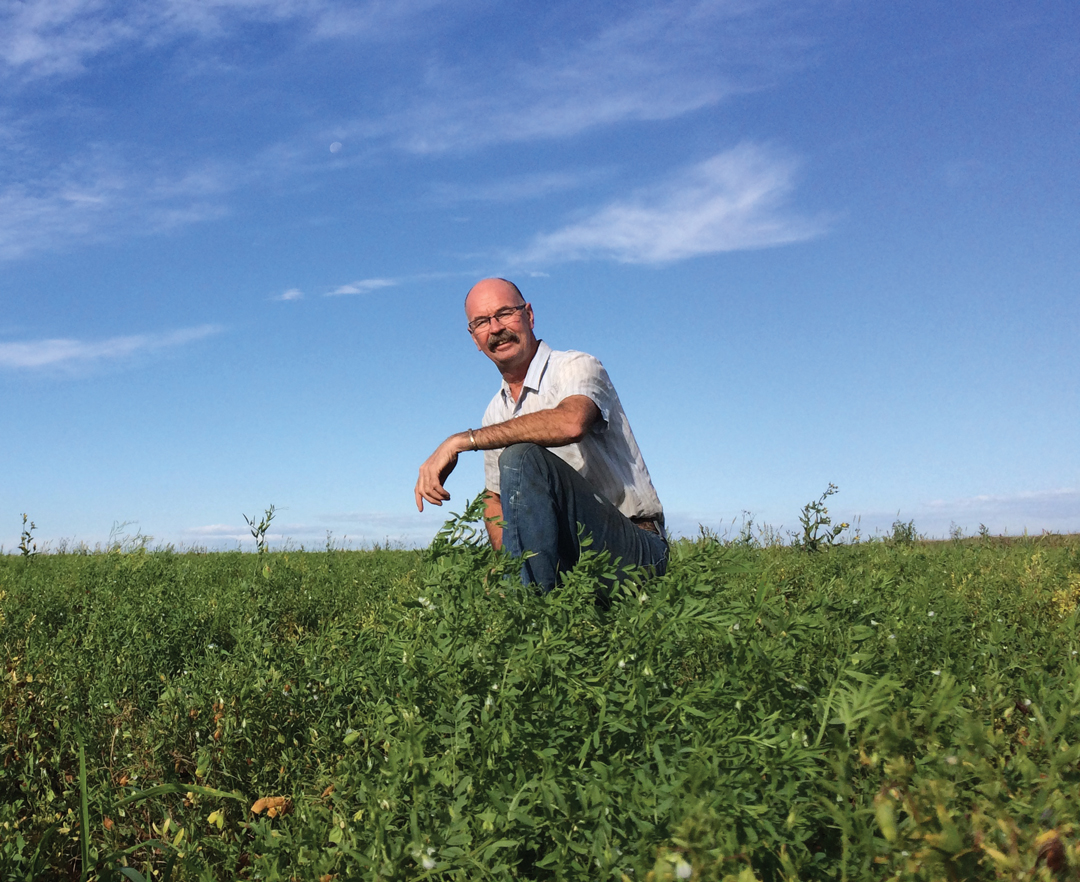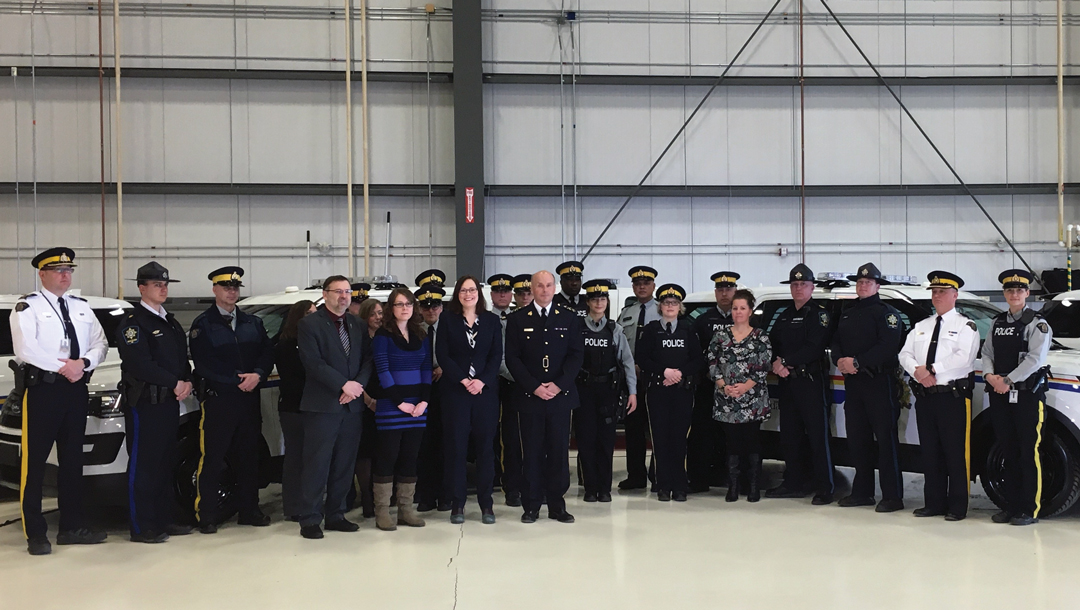CRISIS CONTROL
RURAL CRIME SURGE BRINGS INCREASED VIGILANCE, DETERRENCE AND BETTER POLICING
BY IAN DOIG • ILLUSTRATIONS BY KYLE METCALF
Nine years out of 10, Doug Sell would have been in the field on Thanksgiving. But with snow on the ground this past fall, he and his family spent the day at his sister-in-law’s home. The following day at noon, he drove to his shop about half a kilometre from his house. “That’s when I saw the damage,” said Sell, who is Alberta Pulse Growers’ zone two director and farms wheat, canola and pulses between Rockyford and Beiseker.
Sometime over the preceding day-and-a-half, thieves had jimmied the main door and ransacked the building. Finding the keys in the shop truck, they vanished with the vehicle and equipment that included a slip tank, generator and welder. They had also broken the spigot off a gas tank while attempting to break its lock, spilling 500 gallons of gasoline onto the ground.
“We were far enough from the big, bad city that crime didn’t come out this far,” he said. “With three [thefts] in the last six months within a stone’s throw, we are not such an isolated, insulated community.”
Filing an insurance claim and paying a hefty deductible, he soon had the replacement equipment required to finish the harvest and fortunately had a second shop truck, but he described the experience as “a real royal pain.”
Farmers, Sell included, have been reluctant to speak publicly about rural crime, not wishing to draw further attention as targets. Now, he and his neighbours have vowed to be more vigilant and want criminals to know it.
“It changes our rural lifestyle, but you see a strange vehicle on the road that’s driving slowly, you stop and find out who it is,” explained Sell. “That’s the positive spin that I want to see on it. As long as we’re more vigilant and the bad guys know it, they’re simply going to stay away.” It’s a proactive attitude that appears to be sweeping the province.

CRIME RATES AND THE ROOT CAUSE
Statistics Canada has reported a five per-cent rise in Alberta’s Crime Severity Index for 2017. The agency also reports that the province’s rural crime rate was 42 per cent higher than in its urban centres that year. As well, with just 12 per cent of Canada’s rural population, Alberta experienced 21 per cent of the nation’s rural crime.
Putting these numbers in perspective, Doug King, a professor of justice studies at Mount Royal University, explained that crime rates have generally dropped 35 per cent since the mid-1990s, meaning any given Canadian is 35 per cent less likely to become a victim of crime than were their parents at the same age.
He also noted that while urban centres have more crimes and receive more attention as a result, the rate of crime in rural Canada has always been higher. Particularly in Alberta, the upswing in rural crime in recent years has been pronounced in areas adjacent to cities and is a spillover effect of increased illegal drug activity. “It’s methamphetamine and heroin,” said King. “People are getting horribly addicted and turning to crime to survive their addiction. That’s what’s bumping crime rates up.” He suggested dealing with this root cause will effectively reverse the trend.

Hit by the theft of equipment and tools, farmer and Alberta Pulse Growers’ zone two director Doug Sell said he and his neighbours have vowed to be more vigilant. Photo courtesy of Alberta Pulse Growers.
POLITICAL AND PUBLIC DEBATE
The stats don’t put rural crime at a crisis level, and King suggested that while all crime tends to be underreported, this is not the case with serious crime and would not affect the overall assessment of crime levels in rural communities. But, within the farm community, crime has caused a very real existential crisis.
Alberta’s opposition politicians have taken note. Last July, the United Conservative Party (UCP) released A Safer Alberta: United Conservative Strategy to Tackle the Rural Crime Crisis, a report prepared by former Alberta Crown prosecutor Scott Newark with input from the party.
“Many of our opposition MLAs were raising these issues in the legislature and then it just blew up,” said Airdrie UCP MLA Angela Pitt. “When you door-knock in these rural areas, there’s this level of anxiety that you’ll get from many constituents because they don’t know you or the car you drove up in.
“And it has bubbled up into cases where people have felt their only option is to take action themselves. The case of Eddie Maurice in southern Alberta is an example of how frustrated and how scared people are in rural Alberta.” Maurice, an Okotoks-area farmer, was cleared of charges after a warning shot he fired to scare trespassers ricocheted and injured one of them.
Pitt said the main concerns heard during town hall sessions included 911 calls receiving slow responses or none at all. “Many rural Albertans have had multiple break-ins and feel like they’re not being heard. They feel like nothing is happening to our criminals.”
The UCP report is intended as a blueprint for action, should the party form government. Its recommendations include the creation of a victims’ ombudsman office and reducing sentencing delays. It also recommends lobbying the federal government for Canadian Criminal Code changes that would preclude the prosecution of victims of crime and add mitigating factors for consideration when rural property owners are prosecuted for use of force in self-defence.
“I think it’s a very reasonable ask,” said Pitt, noting the Conservative Party of Canada partnered with the UCP in studying rural crime and calls for the same action in its own report.
King suggested there’s no question criminals engaged in on-farm crime are likely to be armed. Urban police have found suspected perpetrators increasingly carry weapons, and it stands to reason that they may be armed when prowling rural properties. However, while he said the role of political discourse in the debates is very important, it’s unlikely the Criminal Code will be altered.
“From my perspective, the current Criminal Code provisions are suitable and would fit,” he said. “The provisions for use of force are largely that you can use as much force in repelling someone as the force they are using towards you.” In cases where excessive force is used as a scare tactic, he said the decision to lay charges lands with the Crown prosecutor. “It’s in these situations the Crown needs to do a real fulsome look at the circumstances of a case before they decide to lay a charge.
“It would potentially be opening an incredible door to suggest there will be some general exceptions built into the Criminal Code if, hypothetically, someone living in a rural community can use a different level of force than might be [used] in an urban environment,” said King. Such a move, he explained, would contravene the Canadian Charter of Rights and Freedoms and couldn’t be passed. “Is it going to happen? Hell no. Is there anything wrong with trying to advocate for it? Oh, hell no.”
Importantly, the public and political debate on the issue has driven the provincial government, police, volunteer organizations and rural residents to take action.

In March, 2018, Minister of Justice and Solicitor General Kathleen Ganley and RCMP Deputy Commissioner Todd Shean announced the launch of the province’s $10 million rural crime reduction strategy. Photo courtesy of the Government of Alberta.
MAKING A CHANGE
On March 9, 2018, the Government of Alberta launched a rural crime reduction strategy created in cooperation with the RCMP. It adopted methods the force has successfully implemented elsewhere. “We worked in partnership with the RCMP to determine how funding could be used in the most efficient and effective way, with a view toward what could be implemented quickly and have an immediate impact,” said Jason van Rassel, a communications advisor with the Ministry of Justice and Solicitor General.
The initiative included the allocation of a $10 million injection—$8 million for the hiring of 39 RCMP officers and 40 civilian staff as well as $2 million to hire Crown prosecutors in rural Alberta. Later that year at a November news conference, Kathleen Ganley, Alberta NDP MLA for Calgary-Buffalo, and minister of justice and solicitor general, said a total of 59 officers, which included the 39, had been hired “between the rural crime strategy and budget.” In 2018/19, the province reported spending $500 million on policing, including 1,560 rural officer positions.
This seven-point strategy to reduce rural crime featured the establishment of four regional Crime Reduction Units. These are tasked with arresting repeat offenders and extinguishing crime hotspots. A civilian criminal analyst and an RCMP supervisor are attached to each mobile, five-officer unit associated with one of four districts—eastern, central, southern and western. They can assist any detachment or work on crime trends affecting various areas. From February to November 2018, Ganley said the units made nearly 700 arrests and laid approximately 2,300 charges.
“In making these arrests and laying these charges, the targets are repeat offenders,” said Laurel Scott, a media relations officer with the Alberta RCMP K Division in Edmonton. “Our goal is to have them stop offending.” She said a small group of habitual criminals is responsible for a large amount of crime. Measures include having them held in custody or facing increased jail time, but also providing social assistance.
Perpetrators tend to cross jurisdictional borders such as those between detachments, police forces and provinces. “With mobile units, we have the ability to target and try to stop them,” said Scott. Information sharing is key to the new policing effort. Each unit analyst also acts as an intelligence coordinator, gathering and sharing information with partnering police agencies.
The establishment of a paperwork policing support service has freed constables for field work and call-back units in Calgary and Edmonton handle non-emergency calls that are non-time-sensitive and don’t pose a threat to public safety. Ganley claimed the units will save more than 9,000 hours of officer time, or the workload of nine general-duty constables annually.
From January to November 2018, Ganley said the strategy saw property crime decline about 11 per cent across rural Alberta. She calculated this would equate to 366 fewer break-ins, 648 fewer vehicle thefts and almost 2,400 fewer total thefts from the year prior. “It’s important to remember, in each instance, those statistics represent families who feel safer in their home. We know that we still have more work to do.”
“It’s understandable that reduction isn’t going to be felt by someone who has been a victim of crime,” added van Rassel. “We’re going to continue working with our law enforcement partners and the justice system to provide the resources they need to address crime and prosecute the offenders.”
Though the UCP report proposes different methods, it embodies much common ground with the NDP rural crime strategy. This includes working with enforcement agencies to improve data collection and inter-jurisdictional cooperation. They also share an emphasis on greater public education and and stopping repeat offenders.
The UCP’s Pitt said her party is happy to see government action, but that crime rates are still up from 2015. She also suggested it’s too early to accurately make claims about where provincial crime rates are at and Crime Reduction Units simply represent a reallocation of officers. “We certainly hope [crime statistics] get better. There’s a lot of work that needs to be done and there are a lot of people out there that are really scared for themselves and their property.”
Alberta’s crime-reduction strategy includes actions that simply bring it into the 21st century, according to King. “All of those are really appropriate and useful and effective responses, but they were emergency responses,” he qualified. Policing agencies, he said, must realize more visible police presence in rural communities deters crime and that one bureaucratic approach doesn’t fit all communities, but rather, the unique needs of each must be accounted for. “If they commit themselves to doing that, and the province is prepared to provide financial support towards that end, things are destined to have improved in the short run, but will also continue to improve.”
Further aspects of the provincial program include the use of bait vehicles, GPS tracking of stolen implements as well as helicopter monitoring of criminal activities. Additional policing efforts outside the program include rolling out online crime maps through RCMP detachments. It’s a means of creating public awareness and engagement, said Scott. “To be clear,” she added, “we’re not asking the public to respond to crime, but to help prevent crime.”
PARTNERS IN CRIME PREVENTION
To this end, the RCMP partners with the Alberta Provincial Rural Crime Watch Association (APRCWA). The volunteer organization is made up of approximately 55 associations representing 20,000 members. President Cor De Wit is a beekeeper who operates close to the Edmonton International Airport. He explained many APRCWA associations are clustered around the QE2 Highway corridor, while the northern and southern portions of the province are not as well covered due to their size and lower populations. The rural crime issue has re-energized the group and awareness of its activities has grown, though he said membership hasn’t yet increased substantially as a result.
The organization has traditionally operated as extra eyes and ears for the RCMP, and this remains the case. Members are focused on passive patrolling—reporting suspicious people and vehicles when they spot them. What has changed is the APRCWA’s expanded focus on public education, crime awareness and prevention.
Started last year by the Leduc Nighthawks, Leduc Rural Crime Watch Association and Alberta Citizens On Patrol Association (ACOPA), the Lock It or Lose It campaign is an anti-vehicle-theft program that has gone provincewide. De Wit said simply using tamper-proof screws to secure licence plates can stop theft. For instance, he explained, a criminal will steal a three-quarter-ton truck and outfit it with a stolen licence plate from a similar truck. When police run the plate number, it doesn’t come up stolen.
“Keys in the ignition is another huge issue,” noted De Wit. Along with removing the keys from quads, trucks and implements, the group encourages people to record serial numbers. He emphasized police can do nothing when they find stolen goods if no one has reported them missing.
Also partnering with the RCMP and Rural Crime Watch, ACOPA volunteers conduct active patrols in and around rural communities. President Garth Kohlsmith, who ran a local bowling alley for 28 years, heads the Westlock chapter. He pegged membership at close to 2,000 with approximately 75 established chapters and eight more in the application process. He explained these citizens must first pass a background check followed by some training. From there, patrols generally meet with an RCMP liaison prior to hitting the streets of small towns and the roads between them.
Two-member teams typically make their rounds at night in cars bearing the organization’s logo. While they phone in what they see, and officers are dispatched if a crime in progress is reported, Kohlsmith said the patrol program creates a show of vigilance that’s a crime deterrent in itself. “Criminals see us and they know we’ll report them. They all know who we are.”
With the additional willingness to read a training manual and devote six or seven late-night hours a month to the cause, anyone can join, he explained.
Despite the positive statistics, many remain skeptical that the situation is improving. While Scott advised property owners to lock up homes and vehicles, and secure farmyards, she offered reassurance that the RCMP is on the case. “We are hearing your concerns. Trust us. We’re trained, we’re out there more than ever and we’re catching the guys doing these crimes.”
De Wit said that in his area, peace of mind has increased as the crime rate dropped to half of what it was a year prior and there had been no vehicle thefts for three months. “I just hope that people don’t stop being vigilant,” he cautioned. “That’s the secret here—to make sure we don’t drop our guard.”







Comments